Foreword / YouTube Video Review
The review on this website is a brief overview and summary of the objective performance of this speaker. It is not intended to be a deep dive. Moreso, this is information for those who prefer “just the facts” and prefer to have the data without the filler.
However, for those who want more - a detailed explanation of the objective performance, and my subjective evaluation (what I heard, what I liked, etc.) - please watch the below video where I go more in-depth.
I reviewed the big brother JBL HDI-3800 floorstanding speakers here if you are interested in those as well.
Information and Photos
Note: JBL was kind enough to loan me this item for test. I was not paid for my review and was not told what to say.
The JBL HDI-4500 is 2.5-way center channel speaker. The below is from the manufacturer’s website:
Designed and engineered in JBL’s world-famous acoustic engineering facility in Northridge, California, the HDI-4500 is the anchor of a complete HDI Series surround system. This center channel loudspeaker features a 2 ½-way design with patented High-Definition Imaging (HDI™) waveguide technology, the patented 2410H-2 1-inch (25mm) compression driver, and quadruple 5.25-inch (130mm) Advanced Aluminum Matrix cone woofers for powerful dynamics and incredibly accurate sound reproduction. The HDI-4500 enclosure is heavily braced to provide a solid acoustic foundation, and incorporates a bass reflex design with dual rear-firing, computer-optimized flared ports. The sophisticated curved cabinet features a modern design finished in a choice of automotive-grade painted High Gloss Black, or furniture-grade satin Walnut or Gray Oak wood veneers. A black cloth, magnetically attached grille completes the elegant appearance.
MSRP for the single speaker is approximately $1750 USD.
And here are some specs, again from the manufacturer’s website:
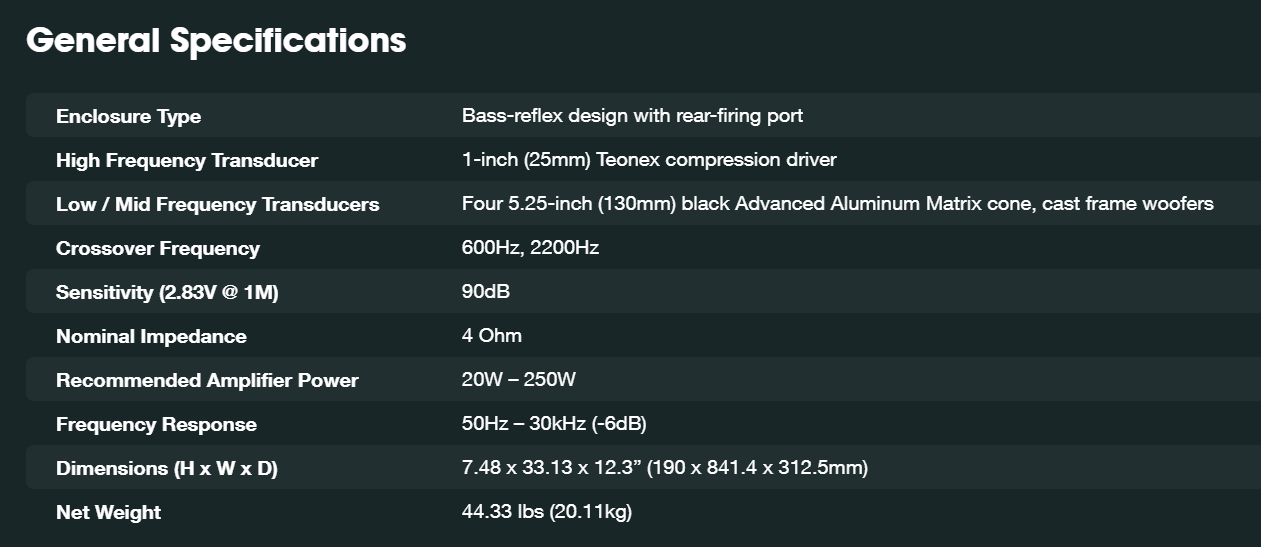
CTA-2034 (SPINORAMA) and Accompanying Data
All data collected using Klippel’s Near-Field Scanner. The Near-Field-Scanner 3D (NFS) offers a fully automated acoustic measurement of direct sound radiated from the source under test. The radiated sound is determined in any desired distance and angle in the 3D space outside the scanning surface. Directivity, sound power, SPL response and many more key figures are obtained for any kind of loudspeaker and audio system in near field applications (e.g. studio monitors, mobile devices) as well as far field applications (e.g. professional audio systems). Utilizing a minimum of measurement points, a comprehensive data set is generated containing the loudspeaker’s high resolution, free field sound radiation in the near and far field. For a detailed explanation of how the NFS works and the science behind it, please watch the below discussion with designer Christian Bellmann:
A picture of the setup in my garage:
The reference plane in this test is at the tweeter. The speaker was tested in ported configuration (the port was not sealed). All testing in this review was done without grille. The speaker was tested in the horizontal configuration (as it is expected this is how it will be used in the real world).
Measurements are provided in a format in accordance with the Standard Method of Measurement for In-Home Loudspeakers (ANSI/CTA-2034-A R-2020). For more information, please see this link.
CTA-2034 / SPINORAMA:
The On-axis Frequency Response (0°) is the universal starting point and in many situations it is a fair representation of the first sound to arrive at a listener’s ears.
The Listening Window is a spatial average of the nine amplitude responses in the ±10º vertical and ±30º horizontal angular range. This encompasses those listeners who sit within a typical home theater audience, as well as those who disregard the normal rules when listening alone.
The Early Reflections curve is an estimate of all single-bounce, first-reflections, in a typical listening room.
Sound Power represents all of the sounds arriving at the listening position after any number of reflections from any direction. It is the weighted rms average of all 70 measurements, with individual measurements weighted according to the portion of the spherical surface that they represent.
Sound Power Directivity Index (SPDI): In this standard the SPDI is defined as the difference between the listening window curve and the sound power curve.
Early Reflections Directivity Index (EPDI): is defined as the difference between the listening window curve and the early reflections curve. In small rooms, early reflections figure prominently in what is measured and heard in the room so this curve may provide insights into potential sound quality.
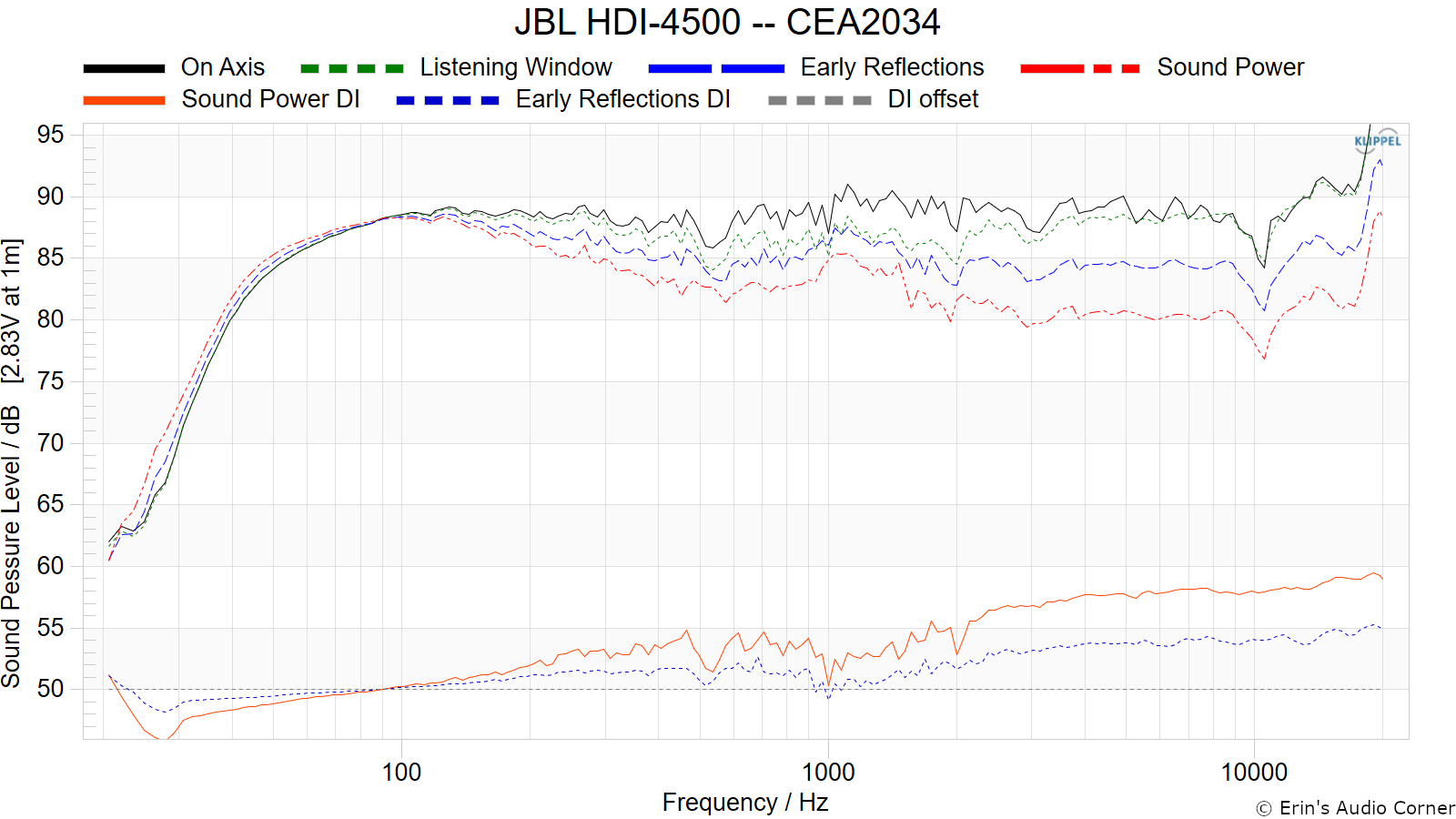
Early Reflections Breakout:
Floor bounce: average of 20º, 30º, 40º down
Ceiling bounce: average of 40º, 50º, 60º up
Front wall bounce: average of 0º, ± 10º, ± 20º, ± 30º horizontal
Side wall bounces: average of ± 40º, ± 50º, ± 60º, ± 70º, ± 80º horizontal
Rear wall bounces: average of 180º, ± 90º horizontal
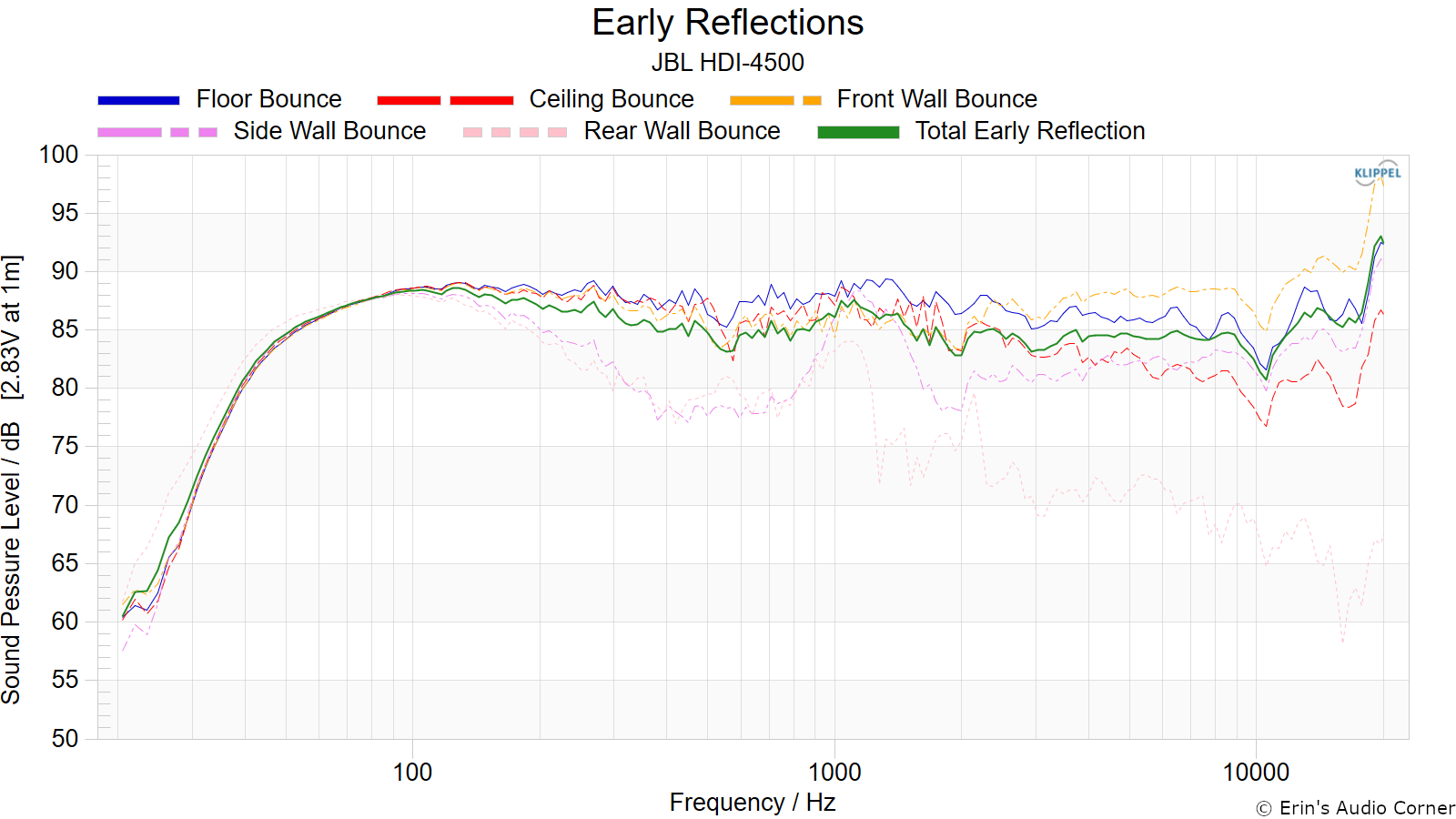
Estimated In-Room Response:
In theory, with complete 360-degree anechoic data on a loudspeaker and sufficient acoustical and geometrical data on the listening room and its layout it would be possible to estimate with good precision what would be measured by an omnidirectional microphone located in the listening area of that room. By making some simplifying assumptions about the listening space, the data set described above permits a usefully accurate preview of how a given loudspeaker might perform in a typical domestic listening room. Obviously, there are no guarantees because individual rooms can be acoustically aberrant. Sometimes rooms are excessively reflective (“live”) as happens in certain hot, humid climates, with certain styles of interior décor and in under-furnished rooms. Sometimes rooms are excessively “dead” as in other styles of décor and in some custom home theaters where acoustical treatment has been used excessively. This form of post processing is offered only as an estimate of what might happen in a domestic living space with carpet on the floor and a “normal” amount of seating, drapes, and cabinetry.
For these limited circumstances it has been found that a usefully accurate Predicted In-Room (PIR) amplitude response, also known as a “room curve” is obtained by a weighted average consisting of 12 % listening window, 44 % early reflections and 44 % sound power. At very high frequencies errors can creep in because of excessive absorption, microphone directivity, and room geometry. These discrepancies are not considered to be of great importance.

Horizontal Frequency Response (0° to ±90°):

Vertical Frequency Response (0° to ±40°):

Horizontal Contour Plot (not normalized):

Horizontal Contour Plot (normalized):

Vertical Contour Plot (not normalized):
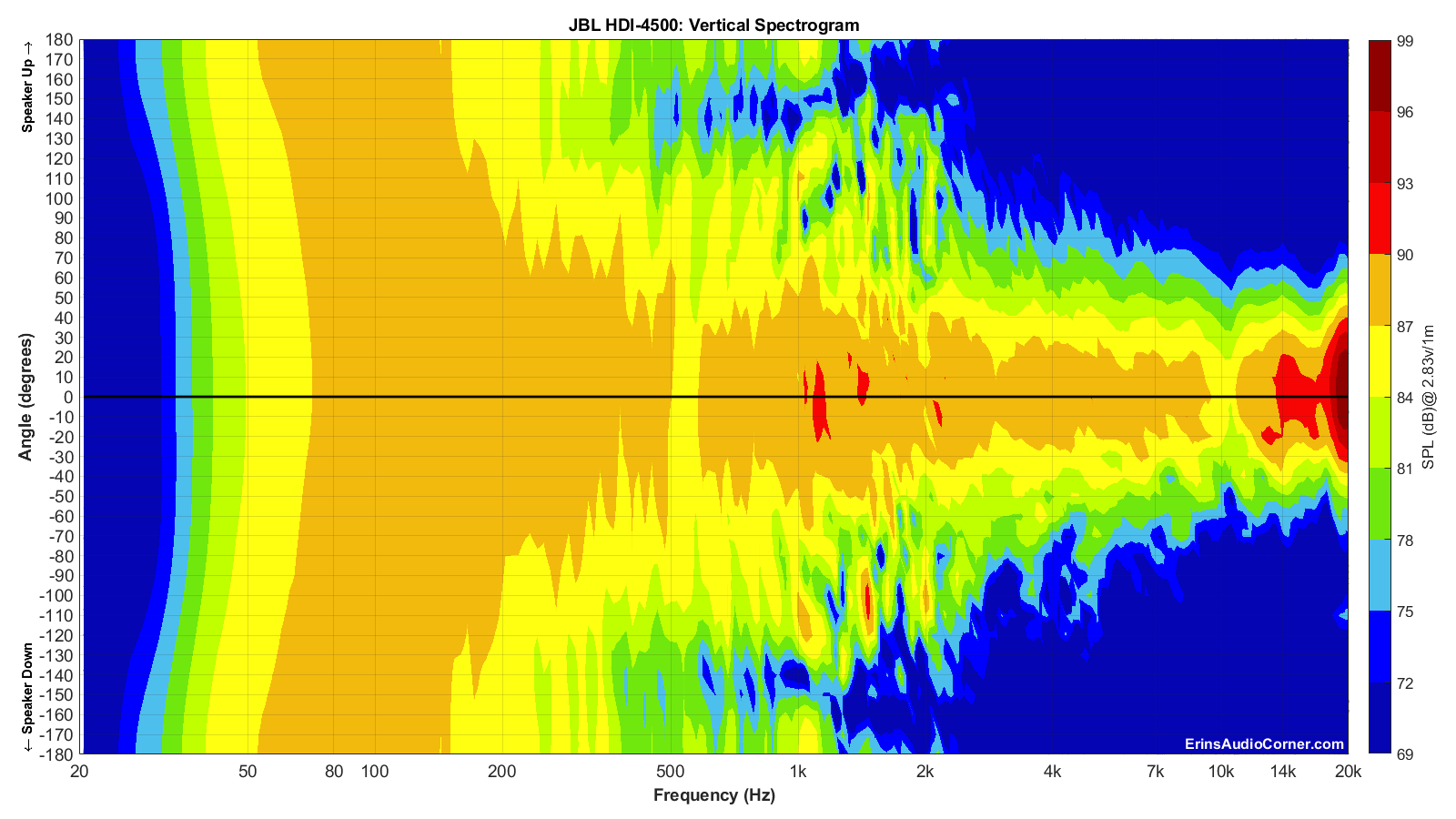
Vertical Contour Plot (normalized):
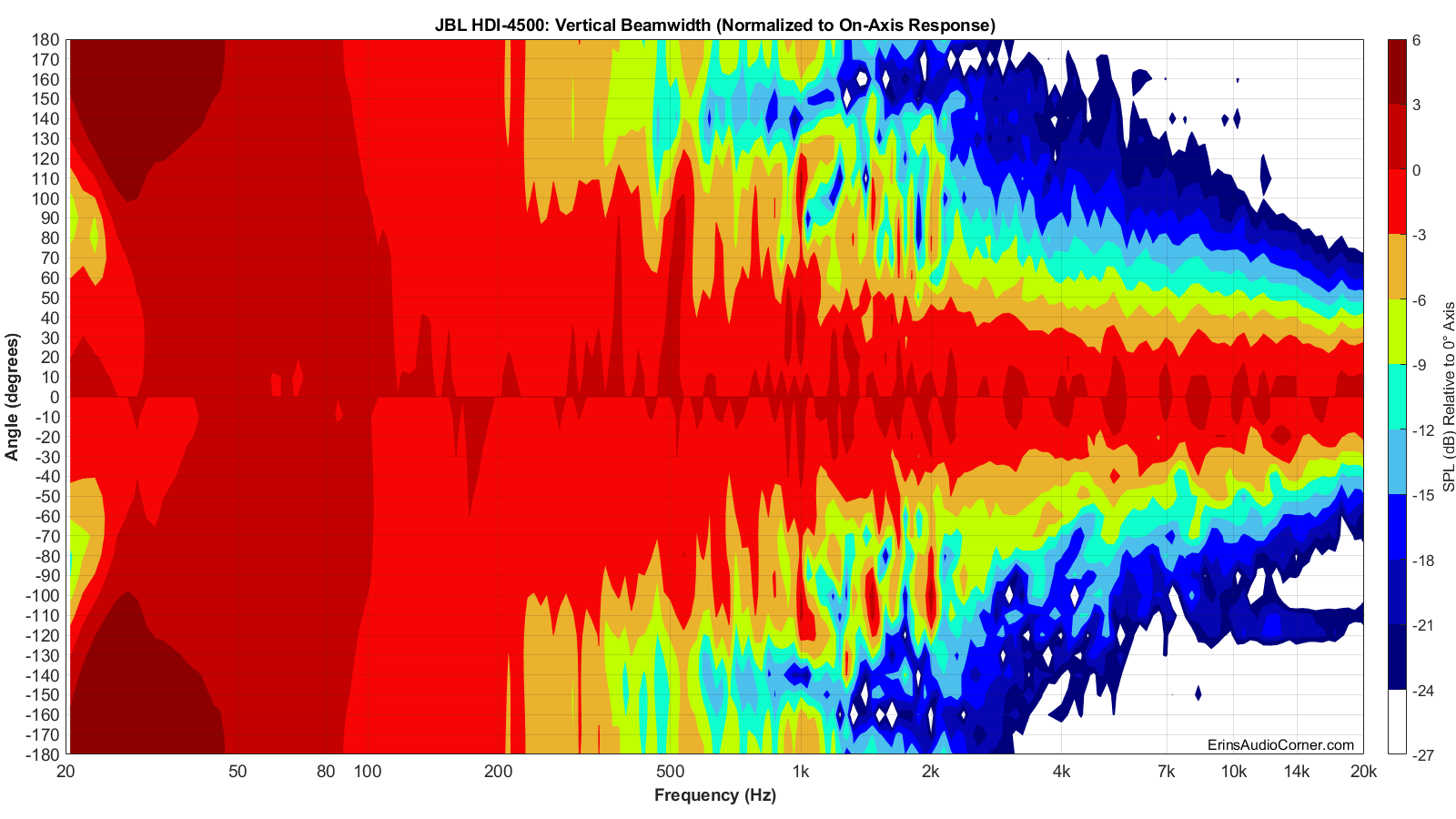
Additional Measurements
On-Axis Response Linearity
The mean SPL on-axis is 88.58 dB (300Hz to 3kHz). Response linearity is -4.37/+3.01 dB (80Hz to 16kHz).

Impedance Magnitude and Phase + Equivalent Peak Dissipation Resistance (EPDR)
For those who do not know what EPDR is (ahem, me until 2020), Keith Howard came up with this metric which he defined in a 2007 article for Stereophile as:
… simply the resistive load that would give rise to the same peak device dissipation as the speaker itself.
A note from Dr. Jack Oclee-Brown of Kef (who supplied the formula for calculating EPDR):
Just a note of caution that the EPDR derivation is based on a class-B output stage so it’s valid for typical class-AB amps but certainly not for class-A and probably has only marginal relevance for class-D amps (would love to hear from a class-D expert on this topic).

Harmonic Distortion
Harmonic Distortion at 89dB @ 1m:
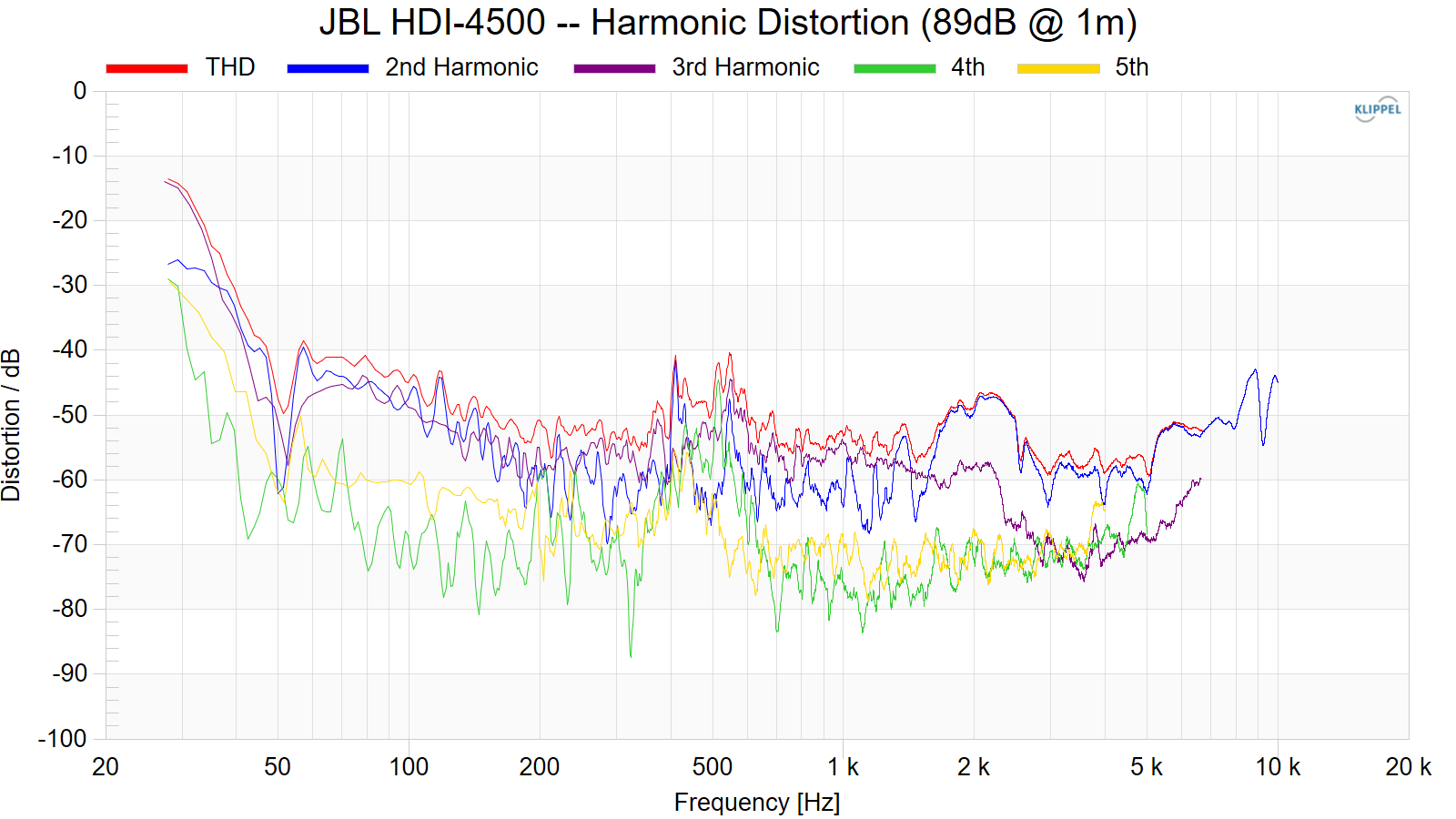
Harmonic Distortion at 97dB @ 1m:
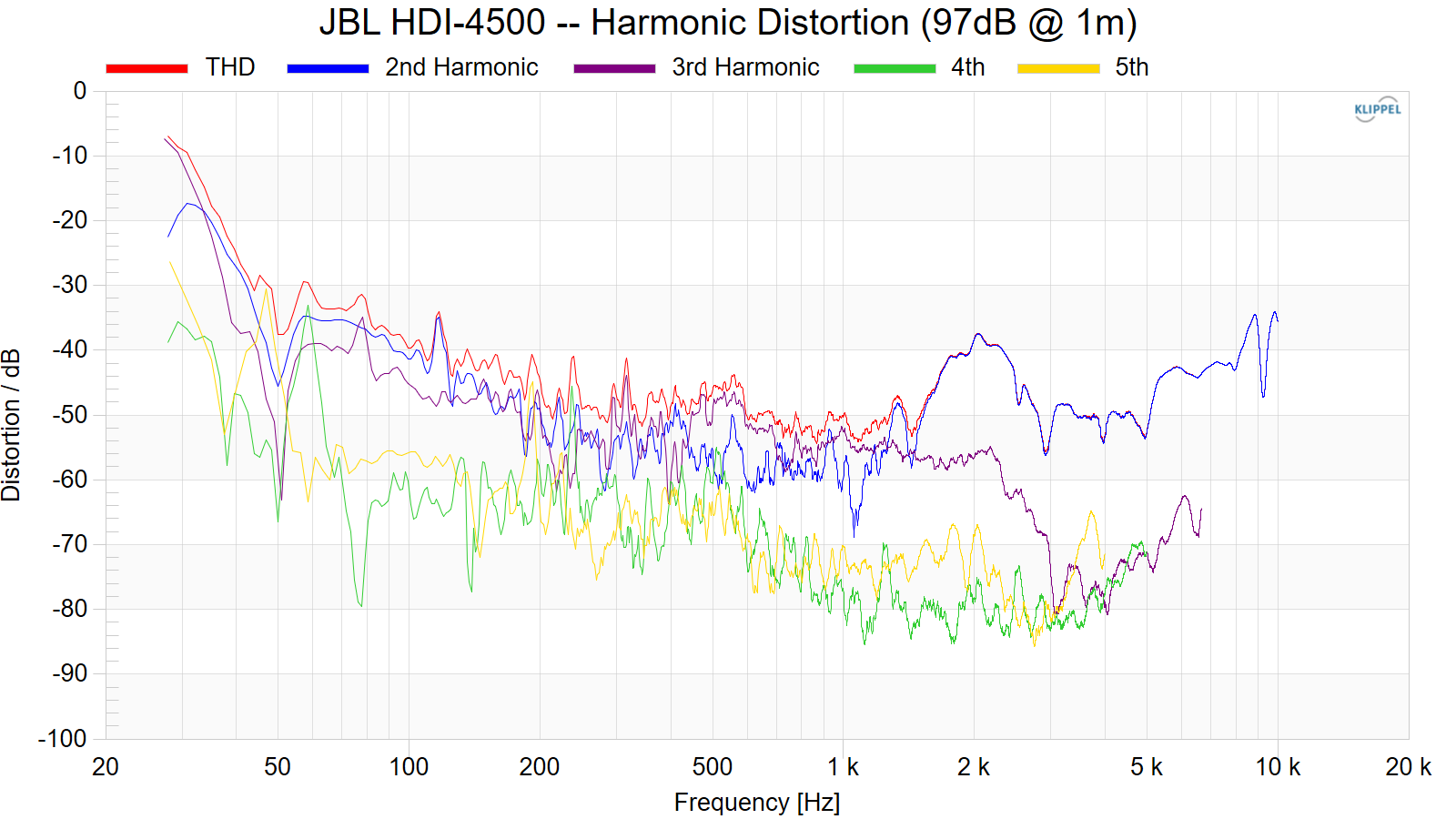
“Globe” Plots
Horizontal Polar (Globe) Plot:
This represents the sound field at 2 meters - above 200Hz - per the legend in the upper left.
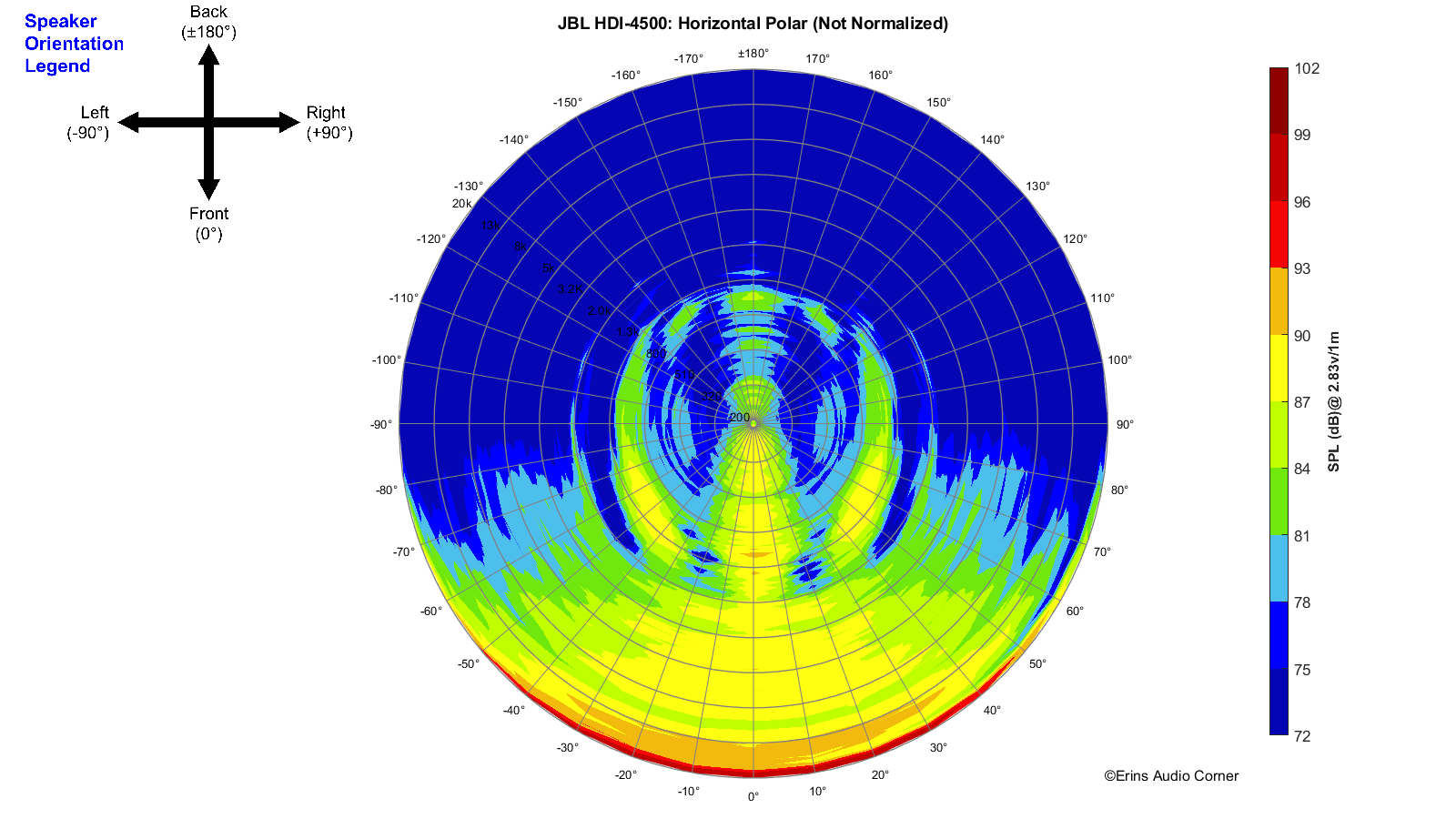
Vertical Polar (Globe) Plot:
This represents the sound field at 2 meters - above 200Hz - per the legend in the upper left.

Parting / Random Thoughts
Generally speaking, it is ideal to use three of the same speakers when building an L/C/R setup and to also keep the same orientation (i.e., all standing). The reason for this is to keep the same speaker quality between the entire front speakers so as dialogue/effects traverses one side to the other of the soundstage the sound “footprint” (if you will) remains the same. This is logical. However, this is typically not feasible unless you are using an acoustically transparent screen with a projection setup. The overwhelming majority of home theater enthusiasts do not have this luxury and instead opt to use a conventional center channel such as the one I have tested here. The issue with these kind of speakers is they are - essentially - floorstanding speakers, laid on their side. This orientation drastically changes the sound you hear at the listening position. Why does this happen? Well, as you can imagine, a single sound source such as a single woofer would have no effect as you turn it on its side because nothing about the radiation pattern changes; it is still that single woofer no matter how you turn it. A single woofer will not produce the full frequency range as well as a multi-way system (midwoofer+tweeter, midwoofer+midrange+tweeter, etc.). But a multi-way has issues of its own. As you incorporate more drive units into a speaker, the more susceptible a poor design is to poor sound. Those drive units have to go somewhere and you have to design a crossover network for them that allows the speaker to project sound in a radiation pattern that isn’t plagued with mismatches in directivity. Making a good horizontally-oriented center channel is tough. Especially for higher output capability. In order to manage these two you need multiple drive units with good horizontal and vertical directivity. The latter isn’t too hard. The former is. I say all of that to say this: when evaluating a horizontal center channel you know you are already starting with a disadvantage compared to a typical bookshelf or floorstanding speaker. As I said, if one is able, they should orient the center channel vertically (unless, in the rare case, the speaker is designed solely to be oriented horizontally).
Now, with that critical caveat laid out, allow me to highlight some things I think will be useful to those who are considering or plan to purchase the HDI-4500:
- The on-axis response averages approximately 89dB @ 2.83v/1m.
- Linearity is pretty good here with a mild trough in the midrange relative to the 1kHz response. In terms of how this will sound, you can expect a mildly “hollow” midrange quality.
- The high-frequency linearity varies significantly above 9kHz. I believe these are diffraction effects of the waveguide with the proximity of the compression driver to the waveguide throat. How audible are these? Well, that’s a tough one to answer for me, at least. There is a 4dB dip at 10kHz in every angle. The narrow-Q shape and the fact that it is a dip lead me to believe it’s not much of an issue. From there the response picks up and peaks around 15kHz before peaking again at 20kHz+. I can’t provide a real assessment on this because I didn’t come across music that highlighted this, at least in a meaningful or noticeable way. Ideally the response would be more linear here.
- The low-frequency extension on this speaker is reasonable, in my opinion, for its size. In my listening tests I found it to pack a lot of “punch” but it didn’t dig very low and a good subwoofer crossed somewhere above the 60-80Hz region is my recommendation.
- You can see directivity changes at the stated crossover points of 600Hz and 2200Hz. Midbass-to-midrange and midrange-to-tweeter, respectively. The latter didn’t seem to be as much of a problem as the former which I get in to in the next bullet point.
- With respect to seating position, it is apparent that sitting more than ±20° to the side of this speaker results in a very recessed midrange quality. The data shows this, notably in the horizontal globe plot by the orange/yellow area in the 300-800Hz region. (The other sets of horizontal SPL data show this, too.) Listening to the speaker is no different in this regard. There is a noticeable loss in speech intelligibility when sitting to the sides of the speaker at an angle greater than 20°. However, if you do some napkin-math you can find that this limit is well-within most seating setups. For example, if you are 8 feet from the speaker to the main listening position then using a maximum angle of 20° off-axis of the center channel means that your buddy/spouse/kid/dog can sit about 3 feet to the side of you. That’s reasonable. At 12 feet from the center channel, the person next to you can sit a little over 4 feet from you. That is feasible for most as well. While the ±20° horizontal angle is my maximum off-axis recommendation, there is a loss in output in the 1-2kHz region at this angle. The ±10° region provides a more uniform sound pattern but it is unlikely that this is achievable in most modern seating situations unless there is no listener directly on-axis. Bottom line? Stay within ±20° of the tweeter axis to the sides and you’ll be OK. Go beyond that and dialogue will suffer for off-axis listeners.
- Now, let’s look at the vertical response window. The vertical response window looks good between ±40-50° so while you would want to aim the speaker at the listening position, you have a bit more flexibility in positioning here. In other words, if you have to place the center channel below your TV in your living room, you’ll be OK as long as you tilt the speaker up and aim it toward your listening position. You have much more leeway here than you do in the horizontal axis.
- The impedance is stated at 4 ohm nominal. The impedance plot shows this to be quite true. I drove this with a Parasound 200 Integrated Amplifier with no issue (rated for 110w @ 4/8 ohm).
- Output levels. I drove this speaker hard for both music and movies and was able to achieve quite high output. Approximately 100dB at 12 feet with no mechanical issues (port noise, speakers bottoming out, etc.). Distortion on this speaker is also quite low.
Support / Contribute
If you like what you see here and want to help me keep it going, please consider donating via the PayPal Contribute button located below. Donations help me pay for new items to test, hardware, miscellaneous items and costs of the site’s server space and bandwidth. All of which I otherwise pay out of pocket. So, if you can help chip in a few bucks, know that it is very much appreciated.
You can also join my Facebook and YouTube pages if you would like to follow along with updates.